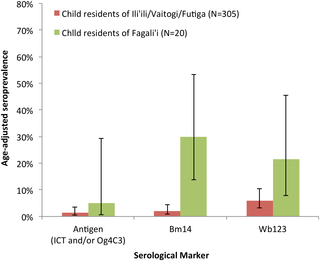PLOS Neglected Tropical Diseases ( IF 3.8 ) Pub Date : 2017-09-18 , DOI: 10.1371/journal.pntd.0005914 Colleen L. Lau , Sarah Sheridan , Stephanie Ryan , Maureen Roineau , Athena Andreosso , Saipale Fuimaono , Joseph Tufa , Patricia M. Graves

|
The Global Programme to Eliminate Lymphatic Filariasis (LF) aims to eliminate the disease as a public health problem by 2020 by conducting mass drug administration (MDA) and controlling morbidity. Once elimination targets have been reached, surveillance is critical for ensuring that programmatic gains are sustained, and challenges include timely identification of residual areas of transmission. WHO guidelines encourage cost-efficient surveillance, such as integration with other population-based surveys. In American Samoa, where LF is caused by Wucheraria bancrofti, and Aedes polynesiensis is the main vector, the LF elimination program has made significant progress. Seven rounds of MDA (albendazole and diethycarbamazine) were completed from 2000 to 2006, and Transmission Assessment Surveys were passed in 2010/2011 and 2015. However, a seroprevalence study using an adult serum bank collected in 2010 detected two potential residual foci of transmission, with Og4C3 antigen (Ag) prevalence of 30.8% and 15.6%. We conducted a follow up study in 2014 to verify if transmission was truly occurring by comparing seroprevalence between residents of suspected hotspots and residents of other villages. In adults from non-hotspot villages (N = 602), seroprevalence of Ag (ICT or Og4C3), Bm14 antibody (Ab) and Wb123 Ab were 1.2% (95% CI 0.6–2.6%), 9.6% (95% CI 7.5%-12.3%), and 10.5% (95% CI 7.6–14.3%), respectively. Comparatively, adult residents of Fagali’i (N = 38) had significantly higher seroprevalence of Ag (26.9%, 95% CI 17.3–39.4%), Bm14 Ab (43.4%, 95% CI 32.4–55.0%), and Wb123 Ab 55.2% (95% CI 39.6–69.8%). Adult residents of Ili’ili/Vaitogi/Futiga (N = 113) also had higher prevalence of Ag and Ab, but differences were not statistically significant. The presence of transmission was demonstrated by 1.1% Ag prevalence (95% CI 0.2% to 3.1%) in 283 children aged 7–13 years who lived in one of the suspected hotspots; and microfilaraemia in four individuals, all of whom lived in the suspected hotspots, including a 9 year old child. Our results provide field evidence that integrating LF surveillance with other surveys is effective and feasible for identifying potential hotspots, and conducting surveillance at worksites provides an efficient method of sampling large populations of adults.
中文翻译:

停止大规模给药后8年,在萨摩亚发现并确认淋巴丝虫病传播的残留热点
全球消除淋巴丝虫病计划(LF)旨在通过进行大规模药物管理(MDA)和控制发病率,到2020年消除该疾病,将其作为公共健康问题。一旦达到消灭目标,监测对于确保持续取得方案成果至关重要,挑战包括及时查明传播的剩余领域。世卫组织准则鼓励进行具有成本效益的监督,例如与其他基于人群的调查相结合。在美属萨摩亚,低频是由Wucheraria bancrofti和Aedes polynesiensis引起的是主要的媒介,LF消除方案取得了重大进展。从2000年到2006年完成了7轮MDA(阿苯达唑和二乙胺嘧啶),并且在2010/2011年和2015年通过了传播评估调查。但是,使用2010年收集的成人血清库进行的血清阳性率研究发现了两个潜在的传播残留点, Og4C3抗原(Ag)的患病率分别为30.8%和15.6%。我们在2014年进行了一项后续研究,通过比较可疑热点居民与其他村庄居民之间的血清阳性率来验证传播是否确实发生。在非热点村庄的成年人中(N = 602),Ag(ICT或Og4C3),Bm14抗体(Ab)和Wb123 Ab的血清阳性率分别为1.2%(95%CI 0.6–2.6%),9.6%(95%CI 7.5) %-12.3%)和10.5%(95%CI 7.6-14.3%)。比较,Fagali'i(N = 38)的成年居民的血清阳性率显着高于Ag(26.9%,95%CI 17.3–39.4%),Bm14 Ab(43.4%,95%CI 32.4–55.0%)和Wb123 Ab 55.2% (95%CI 39.6–69.8%)。Ili'ili / Vaitogi / Futiga的成年居民(N = 113)也具有较高的Ag和Ab患病率,但差异无统计学意义。283名年龄在7-13岁的儿童生活在其中一个疑似热点中,其中1.1%的Ag患病率(95%CI为0.2%至3.1%)证明存在传播。以及四个人的微丝虫病,他们所有人都住在可疑的热点地区,其中包括一个9岁的孩子。我们的结果提供了现场证据,表明将低频监视与其他调查相结合对于识别潜在热点是有效且可行的,



























 京公网安备 11010802027423号
京公网安备 11010802027423号